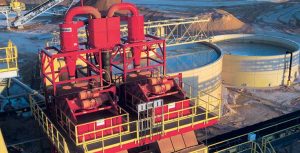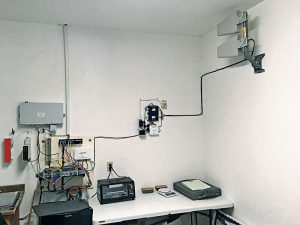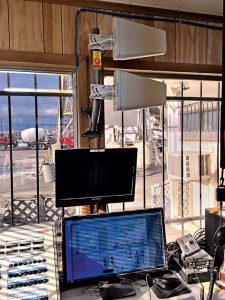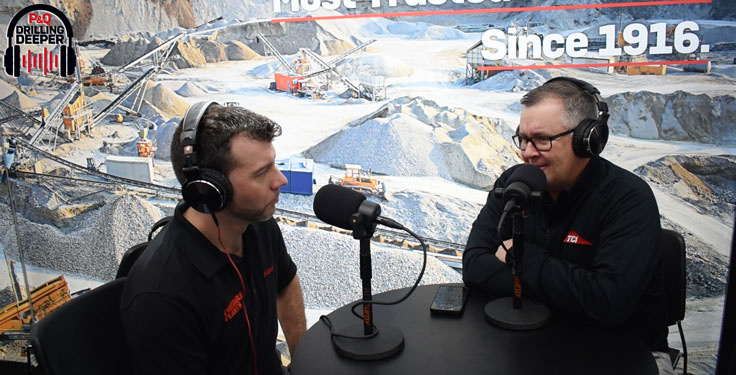Optimizing uptime at Alleyton Resource

One of the connectivity challenges Alleyton Resource faced to keep production going was to have plants connect back to its main office to ensure all data was flowing properly. Photos courtesy of Alleyton Resource
The remote nature of aggregate sites can present signal and bandwidth issues, affecting applications that are fundamental to doing business.
Want to monitor plant downtime? How about track efficiencies related to mobile equipment? A strong, continuous connection is essential to effectively capture this data, but connectivity issues can disrupt operations that want to be on the leading edge of industry technology.
“These are outfits that are using some of the applications you would expect, like video and ERP (enterprise resource planning) applications,” says Jeremy Kerth, president of Boundless Telecom, a telecom solutions provider focused on mid-sized businesses. “In order for those applications to work – and work all the time – you need a network that’s up and responsive all the time.”
Alleyton Resource, a Summit Materials subsidiary with eight sand and gravel sites and eight ready-mix concrete plants in Texas, is one producer who previously experienced outages at an unsettlingly high rate. Many of Alleyton’s sites are rural, meaning some areas have limited networking infrastructure in place.
Also, because a number of Alleyton’s sites are in wide-open areas, storm winds would sometimes take down existing networking infrastructure.
“One of the challenges we had to keep production going was to have plants connect back to the main office to ensure all data was flowing properly,” says Sundeepan Sen, IT manager at Alleyton.
So, Alleyton set out to find solutions that could elevate its network uptime to new heights.
The nature of outages
 According to Kerth, whose company is based in Texas, the network uptime of most rural aggregate locations falls short of the coveted 99.99 percent mark. The uptime of these kinds of operations is likely in the 95 to 98 percent uptime range, he says, meaning operations are down 3 to 5 percent of the time.
According to Kerth, whose company is based in Texas, the network uptime of most rural aggregate locations falls short of the coveted 99.99 percent mark. The uptime of these kinds of operations is likely in the 95 to 98 percent uptime range, he says, meaning operations are down 3 to 5 percent of the time.
Three to 5 percent may not seem like a ton of network downtime, but those few percentage points can be critical to operational flow, Kerth says.
“Even if you’re up 99 percent of the time, that means you’re down 1 percent of the time,” he says. “Well, 1 percent, as long as it’s in the middle of the night, is a number you can live with. But 1 percent of a month is eight hours. So if you’re out 98 to 99 percent of the time or less, your downtime starts to become a big number.”
The source of a site’s signal can be a contributing factor in uptime. Wired circuits are more reliable than a 4G signal, Kerth says, but wire is still highly susceptible to outages. Consider the nature of an aggregate site, and you’ll understand why.
“That wire is susceptible to a lot of issues, including backhoes,” Kerth says. “Backhoes cut what we call ‘the last mile.’ It happens all the time with any kind of construction. Cables get cut, and the Internet goes down. [Wire] is single-threaded in a lot of cases to end users’ locations. Then the site goes down.”
The nature of copper wire, which, in many cases, has been in place for years, if not decades, is a contributor to outages, as well.
“One of the major reasons for wired outages is because signals are carried over copper wire,” Kerth says. “This copper has been in the ground or been aerial for years. These are old networks from the 1960s, 1970s and 1980s. Some of it’s really old, and when that copper gets wet it causes outages.
“Rural locations have a ton of old, wet copper that causes chronic outages,” he adds. “So when it rains, these sites will go down.”
Brian Hollrah, CFO at Alleyton Resource, has experienced what Kerth describes on multiple occasions.
“All of our ready-mix plants are in the Houston metro area,” Hollrah says. “They’re in urban and suburban areas, and we’ve had lines cut there. We’ve even had lines cut on two separate occasions [in 2017] at our corporate office outside of Sugarland.
“Having lost two days toward a month’s end, it can force us to work weekends or nights to get financials done,” he adds.
Solution provided

Alleyton Resource chose to use Boundless Telecom’s Cloud Assurance solution for all of its available remote sites. Cloud Assurance provides a primary and backup network connection, which, in this case, was Internet.
The same types of issues happen at aggregate sites.
“If we go down, we won’t be able to track our production,” Hollrah says. “Is our yellow iron up and running? Are our guys being efficient? We need that info.”
More aggregate operations these days want this information, as well.
“Summit Materials purchased Alleyton in 2014, and they’re very IT focused,” Hollrah says. “Summit likes real-time information and we have embraced it as well. We are focused on [key performance indicators], so we can manage our business better. Right now, we’re doing some pilots on telematics solutions, monitoring fuel consumption and usage for all of our yellow iron. We’re doing daily downtime tracking, as well.”
But doing business in this fashion means optimizing network uptime. And that’s where Alleyton came together with Boundless Telecom, which deployed 4G as a wireless backup to the company’s primary connection that promotes failover and failback in the event of an outage.
After seeing improvements and reliability in the network for an initial site, Alleyton selected Boundless Telecom’s Cloud Assurance solution for all of its available remote sites. Cloud Assurance provides a primary and backup network connection, which, in Alleyton’s case, was Internet.
Boundless Telecom utilizes two pieces of equipment to terminate the two services and layer its 24/7 network operations center monitoring on top to manage it all. In the case of an outage, Boundless Telecom is monitoring Alleyton’s connections to quickly isolate issues and deliver fixes.

Boundless Telecom also layered on a network monitoring service to aid Alleyton Resource in the event of an outage.
One site-specific problem Alleyton experienced before teaming with Boundless Telecom was related to a video camera monitoring a scale.
“They were using a video monitor way back on a property,” Kerth says. “They tried to get fiber (wire) back to the scale but it was like a $30,000 cost. That just wasn’t going to make sense.”
So Alleyton went with 4G, and Boundless Telecom provided a Cradlepoint router to boost the signal to the scale operation and, subsequently, stabilize the video.
“There are some tricks to 4G,” Kerth says. “When you’re in these remote areas you have to use directional antennas and a booster. We boost the signal coming from the tower in tandem with that directional antenna.”
Similar measures were taken at other Alleyton locations that resulted in positive outcomes for the company’s use of telematics.
“Our industry is really starting to move toward telematics,” Hollrah says. “We’re going through some posits right now, seeing how efficient operators are, checking cycle times or if there’s a holdup. We want to be ready for that, because that’s where we’re really going to get the bang for our buck, especially as we continue to grow.”









